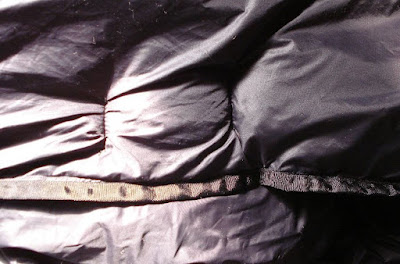This project, a synthetic quilt for cool-weather use, is my third major project. (The most recent prior project was a MYOG Pyramid Tent.) Up to now I have been using a standard synthetic sleeping bag I bought a few years ago for car-based family camping trips. It has served me well as I have gotten back into hiking over the past year, but it has a few drawbacks - namely, it's big, heavy (2.2kg) and not particularly warm.
- For insulation - 5oz Climashield Apex
- For the quilt outer - Momentum 90-MR ('mini-ripstop')
- For the inner liner - Momentum 90-T ('taffeta')
- For edging - 1" grosgrain
My original plan was to have black for the liner and a nice, royal blue-coloured shell. However, Thru-hiker were apparently out of the blue and instead put black MR into the order. I was ambivalent - blue would have been nice and was my preferred colour, but, at least, with all black, the choice of thread was going to be easy and black is about the only polyester thread colour I can actually source locally (in Melbourne).
 |
| The Thru-hiker order arrives |
 |
| The Climashield burst out of the box |
 |
| Ready to go |
Dimensions
I had given a bit of thought to the dimensions to be used, referring to designs from Backpacking.net, Backwoods Daydreamer and MLD. My initial dimensions were as follows:
- Neck 46"
- Shoulder 54"
- Hips 46"
- Foot Width 40"
- Length 72'
 |
| Cutting the Momentum was straightforward. I used a white sewing pencil to mark up the pattern. |
 |
| The pinned up quilt and footbox. I used a flat-sided oval shape for the footbox. I used a dinner plate to get the curve right at each end. |
 |
| Sewing didn't take too long - a couple of evenings for the bulk of it, then another night to make some changes. |
The finished quilt
 |
| The length is just right for me, with head sticking out (plus beanie for the cold weather!) |
 |
| Close up of the clip and toggle system for the neck. |
 |
| I use a couple of some sewn in cord loops with a Velcro (hook & loop) strap to hold the quilt in around my middle. |
 |
| The grosgrain ribbon provides strenghthening to the edges. |
 |
| An example of the extra stitching needed to hold the insulation in place. |
 |
| Close up of the footbox. |
In the field
I used the quilt in the field for the first time last weekend, when I went snow shoeing to Craig's Hut, near Mt Stirling (see story here). It wasn't a super cold night - it only got down to 0-1 degree C. I found that I was quite toasty in the quilt, despite wearing less clothes than on a chillier night I spent recently in my older bag. I should point out here that this quilt is meant to be part of a sleeping system, which in colder conditions should include additional clothing, as required. For the night at Craig's Hut I wore thermal underwear, a fleece top, wool socks and a beanie. For temperatures below say, minus 5, I would expect to also have to wear a down vest and some gloves.
 |
| Field testing |
 |
| Close up of the neck clips |
 |
| The centre tie strap |
The numbers that count.
When squeezed into a stuff bag the quilt can be comfortably gotten down to around 40cm long and 58cm circumference.
The quilt and stuff bag weigh a total of 630gms (22 oz) - that's a huge drop from the 2.2kg I'm used to lugging around!
In terms of cost the original Thru-hiker order cost $125, including $45 delivery to Australia (ouch). By the time I added in thread, a snap connector kit, shock cord, toggle and a bodkin (to thread the neck cord) the total was closer to $140.
In terms of cost the original Thru-hiker order cost $125, including $45 delivery to Australia (ouch). By the time I added in thread, a snap connector kit, shock cord, toggle and a bodkin (to thread the neck cord) the total was closer to $140.
And a final word..
I think I am going to really enjoy this quilt - I know Fergie approves - while my hands are tucked away inside, my face is defenceless.











Thanks for sharing. Very useful info! How about your further temperature tests in chillier nights?
ReplyDeleteHi Altair - Thanks for the feedback. Have a look at my Mt Bogong trip blog post - I used it in temperatures down to around -5C on that late winter walk. The quilt worked fine with adequate clothing and inside a Tyvek over bag.
ReplyDeleteHi Andrew. This looks like a fun project. Thanks for posting.
ReplyDelete